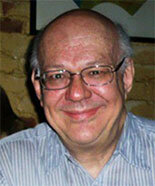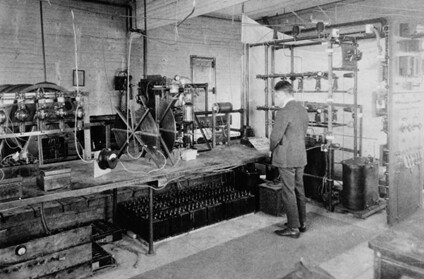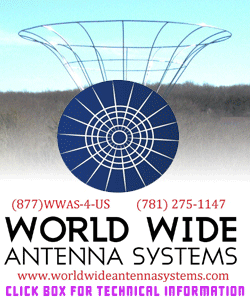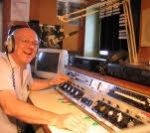Centenary Radio: WGY – Test Ground for Super Power

[February 2022] We continue our series of stations that have operated for 100 years – a real milestone. In fact, of the first 50 stations licensed only a scant dozen or have survived to the present day. WGY was one of even fewer to continue using the same call letters the whole time.
The 40th license given out by the Department of Commerce (DOC) for broadcasting, and carrying the serial number 285, was issued on February 4, 1922 to the General Electric Company. It specified a 1500 Watt facility on 833 kHz at Schenectady, NY.

Of course, this was not the first license General Electric held. As the Schenectady plant was where GE made receivers and radio transmitters, it was natural for GE to build a station so they could demonstrate their wireless receivers, just like Westinghouse was doing with KDKA and WBZ. But while operating as an experimental license, the DOC did encourage the company to convert it to a commercial license.
Thus the experimental 2XI (License #115) led to WGY – and forms the basis for WGY’s claim as the first radio station in New York State.
ON THE AIR
It took just over two weeks from the time the DOC license was issued before General Electric organized the Grand Opening of the station on February 20, 1922.
It was 7:47 PM when the first announcement was made: “This is Station WGY, W, the first letter in Wireless, G, the first letter in General Electric, and Y, the last letter in Schenectady.” Because “WGY” sounded so close to “WJY” in New York City this announcement was read at the beginning of every program for several months.

The first evening’s programming lasted just one hour and three minutes, but featured a variety of music and announcements.
CRANKING IT UP
As World War I developed, the government decided to nationalize broadcast technology.
GE (which by then had bought American Marconi) was the key founder of the Radio Corporation of America (RCA). It was joined in the enterprise by Westinghouse, AT&T, and the United Fruit Company. This arrangement – in addition to providing gear for the Army and Navy – allowed RCA’s members to design and build high-power transmitter equipment designed by GE, Westinghouse, and AT&T, and marketed by RCA. This arrangement continued until 1930.
Being right at the center of innovation, WGY was the recipient of many of the advances, hosting the testing many of the transmitters. As better tubes were developed, they led to higher powered units. According to the FRC and FCC license cards for the period, WGY worked with 30, 50 and 60 kW transmitters – running 50 kW as early as 1925, more than a full year before WLW ran the first Western Electric 50 kW transmitter (the model 107A) in Cincinnati, as well as the RCA model 50A that was put into operation in New York City.
WGY moved to 790 kHz in 1923, then 810 kHz in the Great Frequency Change of 1941.
SECOND HIGHEST POWER LEVEL
In fact, in the records of the day, WGY was shown as holding a permit for 56 kW.
This was the most any station in the US was ever permitted, with the 1930s exception for WLW. As time went on, there were applications from GE for operation at 150 kW and even 200 kW for testing – or for competition with WLW.


It became clear, early on, that transmitter power was limited largely by the tubes available at the time. As many of the stations that already ceased operation could testify, not only were early 1920s tubes difficult to make and expensive, they were not entirely reliable.
GE and Western Electric set out to change that.
LARGER AND LARGER TUBES
Blessed with plenty of available resources, including more than 750 kW of DC power at 15 kV and quite a few available towers – three of them being 300 feet tall – GE kept designing higher and higher powered tubes.
Progress included a 100 kW tube, five of which were used to develop a 100 kW transmitter said to be one-half the size of the previous 50 kW transmitter.
Eventually, Western Electric’s tube design efforts led to the famous WLW 500 kW transmitter, as well as the lesser known but longer active so-called “Apisdistra” transmitter used by the United Kingdom’s government during WWII and afterward. From a WWII propaganda service to the BBC World Service on 648 kHz, this transmitter – originally planned for WJZ in New York City – outlasted WLW’s 500 kW service and was the backbone of the BBC’s World Service for years.
Of course, size was relative. In the 1920s, high powered transmitters were not delivered in a series of cabinets as we now know them. Rather they were set up in large rooms – sometimes with the transmitter building being put up after the transmitter was in place. Tubes were often five or six feet tall.
A SIGHT TO BEHOLD
From pictures of the time, we can see how the transmitter sections, tubes and power supplies were laid out, often in a nicely symmetrical manner.
These “modern” transmitters were actually showcased to host tours for the public.

To protect workers and visitors to the site, safety rails (or sometimes cages) were placed to surround each section.
All-in-all, between the hum of the power and the glow of the tubes, it surely must have been quite a sight to behold.

STILL MORE?
While there is no clear evidence in the FCC record cards that licensed operation did occur at 100 kW, according to Wireless World for October 5, 1927, GE did build a 100 kW model in 1926.
The magazine said the Federal Radio Commission (FRC) had granted WGY a special 30-day experimental license to operate the 100 kW facility between Midnight and 1 AM. WGY itself claims there were actually 200 kW transmissions
However, WGY was not just a test site. The station also was the site of many programming “Firsts.”
For example, WGY claims include:
- presenting the first radio drama The Wolf, in August 1922
- a pioneer World Series broadcast (with WJZ in New York City) by Graham McNamee
- the first use of a condenser microphone
- the first station to help solve a crime (the 1923 kidnapping of Ernst Alexanderson’s six-year-old son)
- among the six stations to affiliate in one of the first networks (1925)
- an original NBC affiliate in 1926
- the first station to market its own food products – coffee, tea, sugar, oatmeal, spices, etc.

AND FM TOO
Along with AM models, GE was also building FM transmitters.
That meant WGY was also placed in the forefront of FM operations. The first iteration of WGY-FM was the experimental W2XDA. That became W85A, according to the calls given to the first FM stations.
Later it became WGFM – now known as WRVE, “The River,” at 99.5 MHz with 14.5 kW.

Today, as WGY celebrates its 100th year from the 1922 license, it is owned by iHeartMedia, and continues its longtime 50 kW operation on 810 kHz in a News-Talk format shared with the FM station on 103.1 MHz.

– – –
Did you enjoy this article? Would you like to know when more articles like this are posted? It only takes 30 seconds to sign up here for the one-time-a-week BDR Newsletter.
